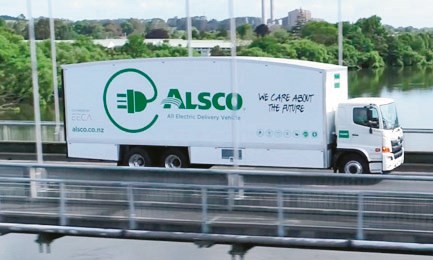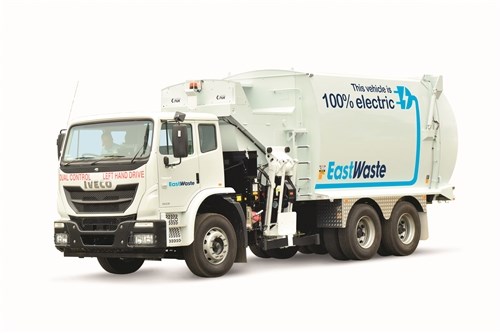There is a commercial electric vehicles future awaiting this country, the domestic elements of which will unfold over the coming years
Like a wave building beneath a surfboard, SEA Electric president Tony Fairweather is feeling a surge of momentum in his business and the commercial electric vehicle (CEV) sector in general.
With 272 units harbouring its SEA-Drive electric power system built or committed to since the company’s commercial inception in 2017, he foresees another three-figure year this year and will be looking for four figures by 2022.
It may be unwise to assume any hyperbole here, given the company now has a presence in Australia, New Zealand, the US, Thailand, South Africa and Israel.
And given that it is opening an office in Vienna and is looking to gain full European compliance green light by the second-half of this year.
And that SEA-Drives can now be found in a growing list presently comprising Isuzu, Hino, Iveco, Ford van, Mercedes-Benz and Dennis Eagle vehicles, the latter two for waste-trucks – while further afield, though still over limited distance, is a project in Mexico to test a Volvo VNR platform for urban semi duties hauling bread.
Not to mention that its November US order for 100 battery-electric Hino 195 light rigids counts as amongst the largest inked anywhere so far for such vehicles.
Also keeping the current running is the opportunity of exploiting a global power systems market estimated to be worth US$3 trillion (A$4.35 trillion) a year in 18 months to two years’ time and the market for converting relatively young diesel trucks to electric propulsion one estimated to be worth US$20 billion a year.
Plus the continuing development of battery performance, which, according to official US figures, has grown 56 per cent in the 30 months as cost measured in dollars per kilowatt hour has fallen from around US$1,000 (A$1,450) in 2008 to less than US$200 (A$290).
KIWI FOCUS
Even if some ATN readers retain doubts about the likely impact of CEVs on their businesses in their lifetimes, one New Zealand development last year should make them reassess – Alsco NZ’s trial of an aerodynamically bodied SEA-Drive 180-powered Hino GH 1828 to do a daily 286km trip taking in Rotorua-Tauranga and back in the morning, then Taupo and back in the afternoon.
Range – in this case, 200km, bolstered by depot recharging – will continue to be a critical factor in Australian operator thinking. And NZ operators, not unlike those in several other countries, have very focused and conditional financial support to at least come to terms with operational suitability – the Energy Efficiency and Conservation Authority (EECA) low emission vehicles contestable fund.
Gaining the support, which includes road-user charge savings, is crucial. Alsco NZ general manager finance Vanessa Atadeniz sees the total savings at half comparable diesel running costs.
Though the trial won’t wrap up until mid-year, Alsco group general manager NZ Mark Roberts reported in a company video in December: “The freighter seemed to provide and enticing financial case right from the outset.
“Not only will the shareholders be happy, it will greatly progress our own environmental goal to decrease our carbon footprint by 30 per cent before the year 2030.”
Alsco is also busy converting 15 diesel trucks to electric.
VIEW FROM DANDENONG SOUTH
Of course, there are challenges and challengers all around for SEA Electric but the latter are not the traditional names many might expect, those of the global original equipment makers (OEMs).
Asked to nominate its major competition, Fairweather names two US firms, Lightning Systems, the Colorado company powering vans and Ford and Chevrolet medium-duty trucks and buses, and Motiv Power Systems, which sells the Electric Powered Intelligent Chassis (EPIC) for light and medium truck and bus applications.
Which is understandable, as SEA isn’t doing business in the same space as OEMs, even if it works in the commercial vehicle market.
From SEA’s Dandenong South headquarters, the Australian firm sees its product in a strong position, with better performance and lower pricing than the opposition, and while not dismissive of the likes of the eCanter, believes it has that vehicle and similar covered, particularly on range.
“The challenge for OEMs is that they build engines and rely on services and parts,” Fairweather says.
“They have a lot of restructuring and repositioning to do.
“We provide a solution to them.”
He argues that while OEMs have spent heavily on national service and maintenance infrastructure, SEA is in a more nimble space, as vehicle simplicity and fewer moving parts make it more an in-depot proposition.
Rather than mechanics at dealer premises, SEA is developing a small corps of mobile aftersales engineers for more involved servicing.
It has eight globally; domestically there are two in Victoria, on in Sydney and one in Queensland, with plans recruitment in Perth, which now has three vehicles and another in New South Wales and more in Queensland for an expected Brisbane City Council order.
CUSTOMERS’ CUSTOMERS
ATN visited SEA’s headquarters hard on the heels of All Purpose Logistics taking on an electric truck to bolster its Ikea contract.
More on the All Purpose Transport EV launch, here
Indeed, Ikea and its emissionless delivery target of 2025 has proved a boon for SEA and a common denominator for deals with other transport providers, in Victoria’s Kings Transport and NSW’s ANC.
“Ikea came to us after introduction from Kings,” Fairweather says.
While it is an example of a ‘customer’s customer’ dynamic leading to an environmentally-based investment decision, he notes no other customer’s customer that SEA has is “at the same level as Ikea in mandating zero emissions”.
Still, the link is also promising as Ikea is also in Europe and the US – the US deal is at quote stage but Europe is less advanced at time of writing.
Kings was famously an early adopter. It now has three trucks and three vans but it is seen as transitioning from the early vehicles that are based on the FAW glider.
Of the ANC vehicles, SEA Electric reports they have travelled 85,000km, travelling an average of 185km per day on a single charge, and made more than 5,000 deliveries with an average weight of around 2.5 tonnes.
“It is estimated in 10 months the three ANC electric trucks have saved a total of 90 tonnes of CO2,” it says.
LOTS TO LIKE ON LOCAL LEVEL
While government support in Australia for CEV uptake is underdone at a federal level, interest is significant for SEA Electric’s vehicles at state and council levels.
And in its home state of Victoria, the government has been keen to see such enterprises progress in the wake of car-making’s demise.
While the October 2018 announcement of its Latrobe Valley van-building facility in Morwell came with much state government fanfare and support, it is sometimes overlooked that start date is some time in 2021.
The Latrobe Valley means cheaper land yet it is really quite close to Melbourne.
SEA Electric president Tony Fairweather notes some minor drift, a matter of couple of months, in the timing as the company continues to work on sourcing and purchasing suitable land and tweaking the agreement.
Fairweather points out that SEA is “very committed to regional areas” and that the company will run out of space in Dandenong South in early 2021 and the company very much needs to free up assembly space.
Latrobe Valley Authority (LVA) reports the company has a large back order for vehicles, and has employed five staff from Latrobe Valley who are working in their Dandenong facility while the Latrobe Valley operations get up and running.
The priority for the company is first to identify and secure a suitable site, and it will be working closely with local council to have this secured by the end of 2019.
SEA Electric has also started working with Federation Training to align the company’s skill requirements and course offerings.
Local government is an important sector with 11 units there, mostly vans, two buses and a tipper for the city of Yarra.
An indication of its importance is that SEA has a business development manager focused on it.
Fairweather believes state governments are in a position to smooth the path for CEVs without it costing a state anything.
“They could be a catalyst for early uptake,” he says.
For instance, this could be through allowing slightly heavier trucks to be driven on a car licence. Domestically this is at 4.5 tonne whereas elsewhere it’s six tonne.
“Uptake would be huge,” he says, though he admits there may be industrial relations issues attending such a move.
Or, given the payload issues with heavy batteries, allowing payload weigh to determine limits.
He is a fan of New Zealand’s approach, which is not an ongoing subsidy but financial support for one-off competitive projects that allow companies to test and trial to see if it’s suitable.
OEMS: A SYMBIOTIC RELATIONSHIP
How does SEA Electric’s relationship with the OEMs it supplies propulsion for work? The company gave ATN this insight into the process:
ADAPTION
A two-way non-disclosure agreements are signed.
Then 2D and/or 3D drawings of the cab/chassis platform are shared with the SEA engineering team.
Vehicle performance output objectives are agreed and documented.
The applicable SEA-Drive platform is presented in 2D, agreed with the OEM, and then all brackets, mounts, fixtures, etc. are drawn in 3D.
Weekly updates are provided to the OEM, with OEM engineering teams welcome to be actively involved in the development process.
A completely engineered and adapted SEA-Drive system is presented within three months to the OEM engineering executives for approval.
Software and control systems are revised to ensure the agreed performance outputs are achieved.
LOCALISATION/PROCUREMENT
This is facilitated towards the end of the ‘adaptation’ stage, with the SEA procurement team presenting to the OEM a range of components that can typically be fabricated or sourced locally.
SEA can provide resources to seek potential local suppliers and/or support the OEM in locating them.
Any components not able to be sourced locally can be procured directly from SEA and/or various global supplier options.
Once local options are identified, final drawings can be provided for quoting and ongoing supply.
The SEA procurement team will then introduce the OEM procurement team to our core global suppliers, so that relationships and accounts can be established, and direct procurement by the OEM can commence in the near future. At this time the first two completed SEA-Drive kits are purchased.
EXECUTION
Once the first two SEA-Drive kits have arrived at the OEM (in full) and the two glider donor chassis are presented and prepared for assembly, SEA will deploy two trainer technicians and a procurement specialist to the OEM.
Suitable prototype assembly and training facilities will be required, to ensure the time on site is optimised.
At completion of this stage, the OEM will have two fully operational and tested vehicles, trained fabricators, assemblers, engineers and procurement team.
A complete assembly and procurement manual will be provided, including new drawing numbers and suppliers.
The execution stage will typically be completed within four weeks, with all travel and accommodation costs borne by the OEM.
ONGOING SUPPORT
SEA provides 24/7 global telephone and online technical support, as well as a mobile technician for each volume deployment.
The technical team are available to visit the OEM at any time to assist with further developments or optimisation as required.
SEA says it is 100 per cent committed to the success of its OEM partners and the performance and support of its SEA-Drive technology.
Furthermore, its suppliers are also committed to success, evident by back-to-back warranty and 24/7 direct support.








